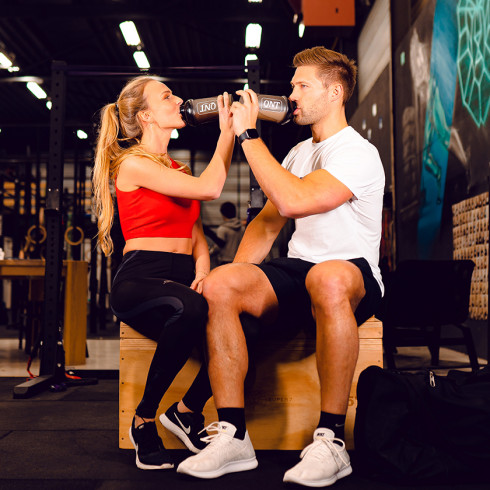Weightlifting and women.
Training Programs for Beginner Women in Weightlifting.
For women starting weightlifting, having a well-structured program is crucial to ensure that training is both effective and safe. Here is a beginner's guide with tailored exercises and progressive training plans.

Summary.
- Training Programs for Beginner Women in Weightlifting.
- Weightlifting and Weight Loss: Optimizing Efforts with Tailored Training and Nutrition.
- Exercises to Tone Specific Parts of the Body.
- Nutrition and Supplements for Women Lifting Weights.
- Weightlifting and Hormonal Health: Effects on Menstrual Cycles and Menopause.
- Myths about Weightlifting for Women: Debunking Misconceptions.
- Coach's Tips.
Why a Specific Program for Beginners ?
- 1. Progressive Adaptation: The body needs time to adjust to new loads and movements. A progressive program allows for the development of strength and endurance without risking injury. Plus, if the next day's soreness is too painful, it can hinder any good resolutions.
- 2. Learning Techniques: Mastering correct techniques is essential to avoid injuries and maximize the benefits of each exercise.
- 3. Balancing Muscle Groups: A well-designed program ensures balanced work on all major muscle groups.
Example of Training Program.
General.
- Warm-up: 5 to 10 minutes of light cardio.
- Abdominals: Alternately touching the knees with the elbows, legs bent: 2 sets maximum
- Leg extension: 2 sets of 15 to 20 repetitions.
- Front lunges: 2 sets of 15 to 20 repetitions.
- Leg curls: 2 sets of 15 to 20 repetitions.
- Bench press: 2 sets of 15 to 20 repetitions.
- Neck chins: 2 sets of 15 to 20 repetitions.
- Z-bar curls: 2 sets of 15 to 20 repetitions.
- Pushdowns: 2 sets of 15 to 20 repetitions.
- Seated flyes: 2 sets of 15 to 20 repetitions.
This general program allows for a gentle start, minimizing muscle stress and facilitating easier technical learning. For those who are not very athletic, sometimes one set may suffice initially. It's always better to start with less and increase next time, as overdoing it can lead to lingering soreness. Once discomfort is manageable, you can increase the number of sets. When 4 sets no longer cause soreness the next day, you can progress to the next level.
Program 2
Day 1: Upper Body
- Warm-up: 5-10 minutes of light cardio (brisk walking, cycling).
- Bench Press: 3 sets of 10 repetitions.
- Dumbbell Rows: 3 sets of 10 repetitions.
- Lateral Raises: 3 sets of 12 repetitions.
- Tricep Extensions: 3 sets of 12 repetitions.
- Abs: Plank, 3 sets of 30 seconds.
Day 2: Lower Body
- Warm-up: 5-10 minutes of light cardio.
- Squats: 3 sets of 10 repetitions.
- Lunges: 3 sets of 10 repetitions per leg.
- Deadlifts: 3 sets of 10 repetitions.
- Leg Curl: 3 sets of 12 repetitions.
- Abs: Crunches, 3 sets of 15 repetitions.
Day 3: Rest or Light Cardio
- 20-30 minutes of moderate-intensity walking, cycling, or swimming.
Day 4: Upper Body
- Warm-up: 5-10 minutes of light cardio.
- Shoulder Press: 3 sets of 10 repetitions.
- Assisted Pull-ups or Lat Pulldown: 3 sets of 10 repetitions.
- Biceps Curls: 3 sets of 12 repetitions.
- Triceps Dips: 3 sets of 12 repetitions.
- Abs: Bicycle Crunches, 3 sets of 15 repetitions.
Day 5: Lower Body
- Warm-up: 5-10 minutes of light cardio.
- Leg Press: 3 sets of 10 repetitions.
- Step-ups: 3 sets of 12 repetitions per leg.
- Hip Thrusts: 3 sets of 10 repetitions.
- Calf Raises: 3 sets of 15 repetitions.
- Abs: Russian Twists, 3 sets of 15 repetitions per side.
Day 6: Rest or Light Activity
- Yoga, stretching, or walking.
Day 7: Rest
Once this program no longer causes discomfort, you can transition to a more traditional training regimen, focusing on 1 to 2 muscle groups per day over 5 days of training per week.
Tips for Successful Training.
- 1. Hydration and Nutrition: Drink enough water before, during, and after your workout. Ensure you have a balanced diet rich in protein to support muscle growth.
- 2. Listen to Your Body: If you experience pain (other than normal muscle fatigue), stop the exercise and consult a healthcare professional.
- 3. Progression of Loads: Gradually increase the weights as you gain strength. Don't rush it; consistency is key to success.
- 4. Support and Motivation: Train with a friend or join a fitness group to stay motivated and accountable.
With this program and these tips, you're ready to embark on weightlifting and discover the strength within you. Good luck, and remember, every little progress is a victory in itself!
Weightlifting and Weight Loss: Optimizing Efforts with Tailored Training and Nutrition.
Weightlifting is often associated with muscle gain, but it also plays a crucial role in weight loss. Here's how weightlifting can help you lose weight and tips to maximize your results by combining training with appropriate nutrition.
The Benefits of Weightlifting for Weight Loss.
- 1. Increased Basal Metabolic Rate: Muscles, as metabolically active tissues, consume calories even when the body is at rest. By increasing your muscle mass, you raise your basal metabolic rate, helping you burn more calories throughout the day.
- 2. Exercise Thermic Effect: Weightlifting, especially compound exercises that engage multiple muscle groups, increases calorie expenditure not only during exercise but also afterward, through Excess Post-exercise Oxygen Consumption (EPOC). This means you continue to burn calories for several hours after your workout.
- 3. Preservation of Muscle Mass: During weight loss, it's crucial to preserve as much muscle mass as possible. Weightlifting helps maintain muscle mass, which is essential to prevent a decrease in metabolism.
Combining Weightlifting and Nutrition.
- 1. Protein Intake: A diet rich in protein is essential to support muscle growth and recovery. Proteins also help you feel full longer, which can aid in controlling calorie intake.
- 2. Controlled Caloric Deficit: To lose weight, you need to consume fewer calories than your body uses. However, it's important not to drastically reduce calories, as this can slow down your metabolism and lead to muscle loss. A moderate deficit, combined with weightlifting, is the best approach.
- 3. Essential Nutrients: In addition to proteins, ensure you have a balanced diet including complex carbohydrates for energy, healthy fats for hormonal function, and fiber for digestion.
Exercises to Tone Specific Parts of the Body.
Exercises targeting specific areas like abs, glutes, and legs are highly popular among women looking to tone their bodies. Here's a detailed guide on the best exercises for each muscle group and how to integrate them into your workout program.
Abs (Abdominals).
1. Crunches:
- Description: Lie on your back with knees bent, hands behind your head. Lift your upper body by contracting your abdominal muscles.
2. Plank:
- Description: In a push-up position, hold your body straight with support on your forearms and toes.
3. Russian Twists:
- Description: Sit on the floor with knees bent and feet slightly elevated. Rotate your torso from left to right while holding a weight or a medicine ball.
4. Bicycle Crunches:
- Description: Lie on your back with hands behind your head. Alternate by bringing your right elbow towards your left knee and then your left elbow towards your right knee.
Glutes.
1. Lunges (Fentes):
- Description: Stand upright, take a big step forward with one leg, and lower your body until the back knee almost touches the ground. Return to the starting position and alternate legs.
2. Hip Thrusts:
- Description: Lie on your back with feet flat and knees bent. Push your hips upwards while contracting your glutes.
3. Donkey Kicks:
- Description: On all fours, lift one leg towards the ceiling while keeping the knee bent. Lower back down and alternate legs.
Legs.
1. Squats:
- Description: Stand with feet shoulder-width apart, lower yourself as if sitting on an invisible chair, keeping your back straight.
2. Deadlifts:
- Description: With a barbell or dumbbells, stand with feet hip-width apart. Lower the weight by bending at the hips and knees, then rise back up.
3. Leg Press:
- Description: Sit on the leg press machine, push the platform with your feet until your legs are fully extended, then return slowly.
4. Leg Curls:
- Description: Lie on the leg curl machine, flex your legs by bringing your heels towards your buttocks.
5. Calf Raises:
- Description: Stand with feet hip-width apart, raise your heels to lift onto your toes, then lower back down.
Integrating these exercises into your workout program will help you tone and sculpt specific areas of your body. The key is consistency, gradual progression, and maintaining a balanced diet to optimize your results. For personalized guidance, consider consulting a fitness coach or healthcare professional.
For more information and additional resources, you can refer to specialized articles on weight training and workout programs for women.
Nutrition and Supplements for Women Lifting Weights.
Optimizing nutrition and supplements is crucial for women engaged in weight training. A balanced diet and the use of dietary supplements can significantly enhance performance, recovery, and overall results. Here are tips and recommendations for effective nutrition and smart supplement use.
Basic Principles of Nutrition for Weight Training.
1. Protein Intake:
- Why?: Proteins are essential for muscle regeneration and development. They aid in recovery after training and building lean muscle mass.
- Recommended Amount: Approximately 1.6 to 2.2 grams of protein per kilogram of body weight per day.
- Sources: Lean meat, fish, eggs, dairy products, legumes, tofu, and plant-based proteins.
2. Carbohydrates for Energy:
- Why?: Carbohydrates provide the energy needed for intense workouts and help replenish muscle glycogen stores.
- Recommended Amount: 3 to 5 grams of carbohydrates per kilogram of body weight per day, depending on the intensity of the training.
- Sources: Brown rice, sweet potatoes, quinoa, oats, fruits, and vegetables.
3. Healthy Fats:
- Why?: Healthy fats are essential for hormone production, vitamin absorption, and overall body function.
- Recommended Amount: Approximately 20-35% of total calorie intake should come from fats.
- Sources: Avocado, nuts, seeds, olive oil, coconut oil, and fatty fish.
4. Hydration:
- Why?: Water is vital for physical performance, recovery, and maintaining electrolyte balance.
- Recommended Amount: Approximately 2 to 3 liters of water per day, increasing intake on days with intense training.
Recommended Supplements.
1. Protein Powder :
- Why? : Ideal for easily increasing protein intake, especially after training.
- Types : Whey, plant-based proteins (pea, rice, soy).
- Dosage : 20-30 grams after training or as a supplement to meals.
2. BCAA (Branched-Chain Amino Acids) :
- Why? : They help reduce muscle fatigue and accelerate recovery.
- Dosage : 5-10 grams before or after training.
3. Creatine:
- Why? : Enhances strength, power, and anaerobic performance.
- Dosage : 3-5 grams per day, preferably before or after training.
4. Beta-Alanine:
- Why? : Enhances muscle endurance and delays fatigue onset.
- Dosage : 2-5 grams per day.
- It is commonly found in many pre-workout supplements.
5. Multivitamins:
- Why? : Ensures adequate intake of essential vitamins and minerals for overall health and performance.
- Dosage : As per manufacturer's recommendations.
6. Omega-3 (Essential Fatty Acids) :
- Why? : They reduce inflammation and promote cardiovascular health.
- Dosage : 1-3 grams per day of combined EPA and DHA.
Example of a Meal Plan for a Day.
Breakfast :
- Vegetable omelette (spinach, tomatoes, bell peppers) with a slice of whole wheat bread.
- Red berry smoothie with a scoop of protein powder.
Lunch :
- Quinoa salad with grilled chicken, avocado, chickpeas, and olive oil vinaigrette.
- An apple.
Dinner :
- Grilled salmon with roasted sweet potatoes and steamed broccoli.
- Greek yogurt with a few nuts.
Snack :
- Protein bar or protein shake after workout.
- Carrots and hummus.
A meal plan combined with a workout routine is suitable as long as you're making progress. When there's stagnation, it's time to make changes!
Adopting a balanced diet and incorporating appropriate supplements can greatly enhance your performance in weight training and your recovery. Make sure to consult with a healthcare professional or a nutritionist to personalize your diet and supplements according to your specific needs.
Weightlifting and Hormonal Health: Effects on Menstrual Cycles and Menopause.
Weight training has significant effects on women's hormonal health, particularly in regulating menstrual cycles and managing menopausal symptoms. Here's an in-depth exploration of these impacts and tips to optimize the hormonal benefits of weight training.
Regulation of Menstrual Cycles.
1. Hormonal Levels Stabilization :
- Exercise Effect : Weight training helps stabilize hormone levels, especially estrogen and progesterone, which play a key role in regulating the menstrual cycle.
- Impact on Premenstrual Syndrome (PMS) : Studies show that regular exercise can reduce PMS symptoms such as cramps, bloating, and mood swings.
2. Stress Reduction :
- Cortisol and Menstrual Cycle : Stress can disrupt the menstrual cycle by increasing cortisol levels. Weight training helps reduce stress, which can promote more regular cycles.
3. Weight Management and Body Composition :
- Healthy Weight : Maintaining a healthy weight through weight training can help regulate menstrual cycles, as excess or deficit weight can cause irregularities.
Management of Menopause.
1. Maintaining Bone Density :
- Prevention of Osteoporosis : Strength training is crucial for maintaining and even increasing bone density, which is particularly important for menopausal women at risk of osteoporosis.
2. Reducing Hot Flashes :
- Effect of Regular Exercise : Studies suggest that regular exercise, including strength training, can help reduce the frequency and intensity of hot flashes.
3. Improvement of Mood and Sleep Quality :
- Well-being Hormones : Strength training stimulates the production of endorphins, the feel-good hormones, which can help improve mood and reduce symptoms of depression and anxiety associated with menopause.
- Quality Sleep : Exercise helps improve sleep quality, which is often disrupted during menopause.
Tips to Optimize Hormonal Benefits of Strength Training.
1. Incorporation of Regular Strength Training Sessions :
- Frequency : Train with weights at least 3 times per week to maximize hormonal benefits.
- Compound Exercises : Include compound exercises such as squats, deadlifts, and bench press to stimulate hormonal production.
2. Nutrition Monitoring :
- Proteins and Healthy Fats : A diet rich in proteins and healthy fats supports hormonal production and aids in muscle recovery.
- Balance of Micronutrients : Ensure you consume adequate amounts of essential vitamins and minerals, such as calcium and vitamin D, to support bone and hormonal health.
3. Stress Management :
- Relaxation Techniques : Incorporate stress management techniques such as yoga, meditation, or breathing exercises to help stabilize hormonal levels.
- Adequate Rest : Ensure you get enough rest and allow your body to recover after workouts to avoid overtraining, which can disrupt hormonal balance.
Strength training is a powerful tool to support women's hormonal health, regulate menstrual cycles, and alleviate menopausal symptoms. By combining a regular strength training program with a balanced diet and stress management techniques, women can optimize their hormonal levels and improve their overall well-being.
Myths about Weightlifting for Women: Debunking Misconceptions.
Strength training is surrounded by many myths, especially concerning women. These misconceptions can deter some women from lifting weights, depriving them of the numerous benefits that strength training can provide. Here are the most common myths and the truth behind each one.
Myth 1: "Strength Training Makes Women Too Muscular"
Refutation :
- Hormonal Differences : Women do not produce as much testosterone as men, a key hormone in muscle development. This makes it extremely difficult for women to build excessive muscle mass simply by lifting weights.
- Reality : Most women who engage in strength training develop a toned and defined physique, not a bulky one. Strength training helps sculpt the body and improve body composition.
Myth 2: "Strength Training Isn't for Women"
Refutation :
- Health Benefits : Strength training is beneficial for everyone, regardless of gender. It improves strength, bone density, cardiovascular health, and can help prevent diseases such as osteoporosis and diabetes.
- Reality : Women can derive numerous benefits from strength training, including better posture, reduced joint pain, and improved mental health through the release of endorphins.
Myth 3: "Light Weights and High Repetitions are Better for Women"
Refutation :
- Efficacy of Heavy Weights : Lifting heavier weights with moderate repetitions (6-12) is often more effective for muscle building and strength than many repetitions with light weights.
- Reality : A balanced training program that includes heavy weights and light weights is ideal for maximizing muscle gains and strength.
Myth 4: "Strength Training Causes Weight Gain"
Refutation :
- Fat Loss : Strength training increases basal metabolism, helping to burn more calories even at rest, which can lead to fat loss.
- Reality : By increasing muscle mass and reducing fat mass, strength training helps to sculpt the body and improve overall body composition. Although weight may sometimes increase because muscle weighs more than fat, the goal of those who want to lose weight is actually not to lose weight, but to have a more beautiful silhouette in the mirror.
Myth 5: "Women Should Avoid Compound Exercises"
Refutation :
- Importance of Compound Exercises : Compound exercises such as squats, deadlifts, and bench presses engage multiple muscle groups simultaneously, which is essential for developing functional and balanced strength.
- Reality : These exercises are beneficial for everyone and should be part of any strength training program, regardless of gender.
Strength training is a beneficial activity for women, contradicting many persistent myths. It helps develop functional strength, improve body composition, and support overall health. By debunking these misconceptions, women can confidently embrace strength training and fully enjoy its benefits.
Coach's Tips.
Related posts
-
 Summer holidays: How to limit the damage?
Posted in: Our tips24/06/2021On holiday, we often tend to let ourselves go. Unless you're a hardcore sportsman, you tend to abandon your trainers...Read more
Summer holidays: How to limit the damage?
Posted in: Our tips24/06/2021On holiday, we often tend to let ourselves go. Unless you're a hardcore sportsman, you tend to abandon your trainers...Read more -
 Which fat burner to choose?
Posted in: Our tips26/05/2021To lose weight and burn fat, there is no secret: you have to do sport and take care of your diet. However, it is...Read more
Which fat burner to choose?
Posted in: Our tips26/05/2021To lose weight and burn fat, there is no secret: you have to do sport and take care of your diet. However, it is...Read more -
 Summer body edition for men: How to prepare your body?
Posted in: Our tips11/05/2021Gentlemen ? The return of the sun and its warm rays are almost here! The degrees are slowly but surely rising, but...Read more
Summer body edition for men: How to prepare your body?
Posted in: Our tips11/05/2021Gentlemen ? The return of the sun and its warm rays are almost here! The degrees are slowly but surely rising, but...Read more -
 9 good reasons to do sport.
Posted in: Our tips22/04/2021Sometimes the urge to exercise is not always there. And although we always tell ourselves that this year will finally...Read more
9 good reasons to do sport.
Posted in: Our tips22/04/2021Sometimes the urge to exercise is not always there. And although we always tell ourselves that this year will finally...Read more -
 Discover how to take care of your faithful companion: your shaker!
Posted in: Our tips07/04/2021In your bag, in your hand, in your sink, it is everywhere! The shaker is an essential element of any good training....Read more
Discover how to take care of your faithful companion: your shaker!
Posted in: Our tips07/04/2021In your bag, in your hand, in your sink, it is everywhere! The shaker is an essential element of any good training....Read more
Blog categories
Popular posts
-
 Looking thinner but at a heavier weight? Is that possible?04/10/2021Posted in: Our tipsAdvertising has shaped our thinking! We have been forced for years to believe that losing weight is the key to having...Read more
Looking thinner but at a heavier weight? Is that possible?04/10/2021Posted in: Our tipsAdvertising has shaped our thinking! We have been forced for years to believe that losing weight is the key to having...Read more -
 Proteins for weight loss !29/12/2023Posted in: Our tipsDive into the fascinating world of proteins and their key role in weight loss. Discover how to choose the best...Read more
Proteins for weight loss !29/12/2023Posted in: Our tipsDive into the fascinating world of proteins and their key role in weight loss. Discover how to choose the best...Read more -
 Which foods boost testosterone levels ?07/05/2021Posted in: Food supplementsTestosterone, often associated with virility, has much more to offer than you might think. It plays a crucial role in...Read more
Which foods boost testosterone levels ?07/05/2021Posted in: Food supplementsTestosterone, often associated with virility, has much more to offer than you might think. It plays a crucial role in...Read more -
 10 BENEFITS OF GLUTAMINE.02/01/2024Posted in: Our tipsDiscover the power of L-glutamine, an underrated superhero in the world of amino acids! Essential for revitalizing...Read more
10 BENEFITS OF GLUTAMINE.02/01/2024Posted in: Our tipsDiscover the power of L-glutamine, an underrated superhero in the world of amino acids! Essential for revitalizing...Read more -
 Is there a link between sex and sport?14/11/2019Posted in: LifestyleMany have already asked questions about sex and sport. Most of the time, people want to be reassured by the many...Read more
Is there a link between sex and sport?14/11/2019Posted in: LifestyleMany have already asked questions about sex and sport. Most of the time, people want to be reassured by the many...Read more

.jpg)

